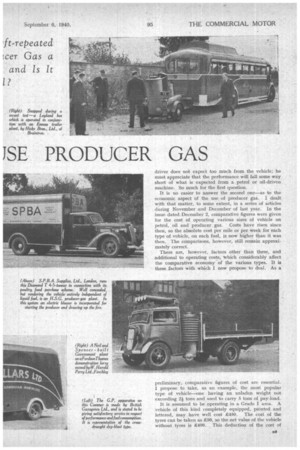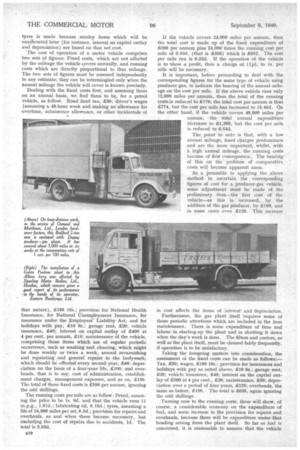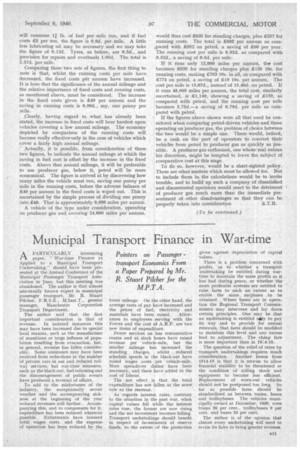WHEN IT PAYS TO JSE PRODUCER GAS
Page 26

Page 27

Page 28

Page 29

If you've noticed an error in this article please click here to report it so we can fix it.
WHEREVER I go, and whenever I meet hauliei friends. I am asked what I think of producergas plants; are they practicable and are they economic propositions? Now this is .a type of question of which, unfortunately, I receive a considerable number. It reminds me of the story of the bullying counsel who, brow-beating a witness, was insisting on a plain " yes" or " no " in answer to his question. The witness said that it was not always possible to answer " yes" or "no." The lawyer said it was, and defied the witness to put a question to him which he could not answer in that way, whereupon the witness said, "Are you as big a fool as -§ou look? "
Incidentally, in view of certain misunderstandings which have arisen over a certain cartoon recently published in The Commercial Motor, I hasten to assert that no such question has yet been put to Me, at least by my haulier friends. [That does not include " C.M." staff.—En.1 It is nevertheless impossible to answer either of the above two questions about producer-gas plants by a plain unequivocal " yes " or "no." The answer to both is "Yes, provided certain conditions are fulfilled." Producer-gas plants are practicable provided that they . are intelligently operated, that the plant is a good one and suitable in size and capacity for the vehicle to which it is fitted, that the right fuel for the plant is used and the fuel properly handled, and that the operator and/or driver, does not expect too much from the vehicle; he must appreciate that the performance will fall some way short of what is expected from a petrol or oil-driven machine. So much for the first question.
It is no easier to answer the second one—as to the economic aspect of the use of producer gas. I dealt with that matter, to some extent, in a series of articles during November and December of last year. In the issue dated December 2, comparative figures were given for the cost of operating various sizes of vehicle on petrol, oil and producer gas. Costs have risen since then, so the absolute cost per mile or per week for each type of vehicle, on each fuel, is now higher than it was then. The comparisons, however, still remain approximately correct.
There are, however, factors other than these, and additional to operating costs, which considerably affect the comparative economy of the various types. It is these factors with which I now propose to deal. As a
preliminary, comparative figures of cost are essential. I propose to take, as an example, the most popular type of vehicle—one having an unladeu weight not exceeding 2i tons and used to carry 5 tons of pay-load.
It is assumed to be operating in a Grade I area. A vehicle of this kind completely equipped, painted and lettered, may have well cost £450. The cost of the tyres can be taken as £50. so the net value of the vehicle without tyres is £400. This deduction of the cost of tyres is made because ,sundry items which will be eninterated later (for instance, interest on capital outlay and depreciation) are based on that net cost.
The cost of operation of a motor vehicle comprises two sets of figures: Fixed costs, which are not affected by the mileage the vehicle covers annually: and running costs which are directly proportional to that mileage. The two sets of figures must be assessed independently in any estimate; they can be intermingled only when the annual mileage the vehicle will cover is known precisely.
Dealing with the fixed costs first, and assessing them on an annual basis, we find them to be, for a petrol vehicle, as follow. Road fund tax, £30; driver's wages (assuming a 48-hour week and making no allowance for overtime, subsistence allowance, or other incidentals of that nature), £189 I6s.; provision for National Health Insurance, for National Unemployment Insurance, for insurance under the Employers' Liability Act, and for holidays with pay, £10 8s.; garage rent, £20; vehicle insurance, £40; interest on capital outlay of £400 at 4 per cent. per annum, £16; maintenance Of the vehicle, comprising those items which are of regular periodic occurrence, such as washing and cleaning, which might be done weekly or twice a week, annual revarnishing and repainting and general repairs to the bodywork, which should be effected every second year, £40; depreciation on the basis of a four-year life, £100; and overheads, that is to say, cost of administration, establishment charges, management expenses, and so on, £150. The total of these fixed costs is £596 per annum, ignoring the odd shillings.
The running costs per mile are as follow: Petrol, assuming the price to be Is. 9d. and that the vehicle runs 11 m.p.g., 1.91d.; lubricating oil, 0.15d.; tyres, assuming a life of 24,000 miles per set, 0.5d.; provision for repairs and overhauls, as and when these become necessary, but excluding the cost of repairs due to accidents, Id. The total is 3.56d. If the vehicle covers 24,000 miles per annum, then the total cost is made up of the fixed expenditure of £596 per annum plus 24,000 times the running cost per mile of 3.56d. • (that is £356) which is £952. The cost per mile run is 9.52d. If the operation of the vehicle is to 'show a profit, then a charge of 1 lid. to Is. per Mile will be necessary.
It is important, before proceeding to deal with the corresponding figures for the same type of vehicle using producer gas, to indicate the bearing of the annual mileage on the cost per mile. If the above vehicle runs only 12,000 miles per annum, then the total of the running costs.is reduced to £178; the total cost per annum is thus £774, but the cost per mile has increased to 15.48d. On the other hand, if the vehicle covers 48,000 miles per annum, the total annual expenditure increases to £1,308, but the cost per mile is reduced to 6.54d.
The point to note is that, with a low annual mileage, fixed charges predominate and are the more important, whilst, with a high annual mileage, the running costs become of first consequence. The bearing of this on the problem of comparative costs will become apparent anon.
As a Preamble to applying the above method to ascertain the corresponding figures of cost for a producer-gas vehicle, some adjustment must be made of the preliminary item—the first cost of the vehicle—as this is increased, by the addition of the gas producer, by £100, and in some cases even £120. This increase in cost affects the items of interest and depreciation.
Furthermore, the gas plant itself 'requires some of those periodic attentions which are included in the item maintenance. There is some expenditure of time and labour in starting-up the plant and in shutting it down when the day's work is done. The filters and coolers, as well as the plant itself, must be cleaned fairly frequently, if operation is to be satisfactory.
Taking the foregoing matters into consideration, the assessment of the fixed costs can be made as follows:— Tax, £30; wages, £189 16s.; provision for insurances and holidays with pay as noted above, £10 8s.; garage rent, £20; vehicle insurance, £40; interest on the capital outlay of £500 at 4 per cent., £20; maintenance, £50; depreciation over a period of four years, £125; overheads, the same as before, £150. The total is £635, again ignoring the odd shillings.
Turning now to the running costs, these will show, of course, a considerable economy on the expenditure of fuel, and some increase in the provision for repairs and overhauls, because there will be expenditure under that heading arising from the plant itself. So far as fuel is concerned, it is reasonable to assume that the vehicle will consume 11 lb. of fuel per mile run, and if fuel costs £5 per ton, the figure is 0.9d. per mile. A little less lubricating oil may be necessary and we may take the figure of 0.12d. Tyres, as before, are 0,5d., and provision for repairs and overhauls 1.05d. The total is 2.57d. per mile.
Comparing these two sets of figures, the first thing to note is that, whilst the running costs per mile have decreased, the fixed costs per annum have increased. It is here that the significance of the annual mileage and the relative importance of fixed costs and running costs, as mentioned above, must be considered. The increase in the fixed costs given is £40 per annum and the saVing in running costs is 0.99d., say, one penny per mile.
Clearly, having regard to what has already been stated, the increase in fixed costs will bear hardest upon vehicles Covering a low annual mileage. The economy depicted by comparison of the running costs will become really effective-only in the case of vehicles which cover a fairly high annual mileage.
Actually, it is possible, from consideration of these two figures, to indicate the annual mileage at which the saving in fuel cost is offset by the increase in the fixed costs. Above that annual mileage, it will be preferable to use producer gas, below it, petrol will be more economical. The figure is arrived at by discovering how many miles the vehicle must run, saving one penny per mile in the running costs, before the adverse balance of £40 per annum in the fixed costs is wiped out. This is ascertained by the simple process of dividing one penny into £40. That is approximately 9,600 miles per annum.
A vehicle of the type under consideration, operating mi producer gas and covering 24,000 miles per annum, would thus cost £635 for standing charges, plus £257 for running costs. The total is 2892 per annum as cornpared with with £952 on petrol. a saving of £60 per year. The running cost per mile is 8.92d. as compared with 9.52d., a saving of 0.6d. per mile.
If it runs only 12,000 miles per annum, the cost becomes £635 for standing charges plus £128 10s for running costs, making £763 10s. in all, as compared with £774 on petrol, a saving of £19 10s. per annum. The cost per mile is 15.07d., instead of 15.48d. on petrol. If it runs 48,000 miles per annum, the total cost, similai-ly ascertained, is £1,149, showing a saving of £159, as compared with petrol, and the running cost per mile becomes 5.75d.—a saving of 0.79d. per mile as compared with petrol.
If the figures above shown were all that need be considered when comparing petrol-driven vehicles and those operating on 'producer gas, the problem of choice between the two would be a simple one. There would, indeed, be a rush on the part of operators to convert their vehicles from petrol to producer gas as quickly as possible. A producer-gas enthusiast, one whose zeal outran his discretion, might be tempted to leave the subject of comparative cost at this stage.
To do so, however, would be a short-sighted policy. There are other matters which must be allowed for. Not to include them in the calculations would be to invite trouble, and to build up such a company of dissatisfied and discontented operators would react to the detriment of producer gas much snore than the immediate presentment of other disadvantages so that they can be properly taken into consideration S.T.R.
(To be continued.)




















































